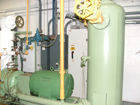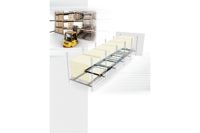Public Cold Storage Warehouse Reduces Energy Costs by 35%
Interstate Cold Storage conducted a
comprehensive modernization analysis, seeking solutions to increase the
efficiency of their warehouses.

The food distribution network in the United States that supplies grocery stores, restaurants and institutional facilities is among the most complex and precise of any mass market product category. Every step within the network has to be work flawlessly to ensure that perishable food is delivered in fresh and stable form; this preserves the reputation of the purveyors and the safety of consumers.
Among the most sophisticated, but lesser known, players in perishable food distribution are public cold storage (PCS) warehouses that rent space to food manufacturers for varying lengths of time. Many large food manufacturers have their own “private” cold storage facilities, but use public facilities for regional storage or for additional space during peak periods. Examples include seasonal storage for hot dog buns or ice cream, leading up to the Fourth of July.
There are many demands with PCS, as a constant rotation of different foods requires varying holding temperatures and different speeds at which they can be frozen and tempered (thawed), as they come in and out of a facility. What works for bread and ice cream is different than that for pork, seafood and poultry. Coupled with often relatively thin margins, any advantage a PCS can gain in operational costs, efficiency and performance are of great value.
Several years ago, one such facility, Interstate Cold Storage (ICS), Fort Wayne, Ind., conducted a comprehensive modernization analysis, seeking solutions to increase the efficiency of their warehouses.
Part of largest 25 facilities in North America
ICS ranks among the largest 25 public cold storage warehousing companies in North America, with five locations in Indiana and Ohio, and nearly 22 million cubic feet of total refrigerated space. The company’s facilities store products at temperatures that range from -20°F to 62°F, and ICS’s many clients include Edy’s Grand Ice Cream, Rich Products Corp. and the Ohio School Lunch Program. For the company’s modernization analysis, they utilized the 22-year-old, 5.5-million-cubic-foot Fort Wayne West facility as a test case to assess the potential energy savings and operational improvements that could be achieved by upgrading the refrigeration infrastructure.
“American Electric Power, our electricity provider, informed us of pending rate increases due to the end of a 15-year moratorium,” says Jerry Tippmann, refrigeration operations manager for ICS. “Cold storage facilities’ largest expenses are energy and manpower, so improving energy efficiency is an obvious area for operational improvement.”
ICS is owned by Tippmann Affiliated Group, which owns more than a dozen companies, including Tippmann Refrigeration, a design/build firm in Fort Wayne, Ind., that specializes in refrigerated warehouses and distribution facilities. Led by project engineer Phil Black, Tippmann Refrigeration conducted the warehouse modernization project on behalf of ICS. Prior to joining Tippmann Refrigeration, Black had been with an independent rep firm that handled ABB variable frequency drives (VFDs), among other products.
“My awareness of the recent leaps in VFD technology and their value-price offer made VFDs a focal point of our analysis,” says Black. “That, coupled with the large number of rotating loads in a public cold storage facility, made the prospect of adding VFDs a high-potential means to achieve improved efficiency.”
There are approximately 1,400 public and 5,000 private cold storage warehouses in the United States. It is estimated that less than 3% of cold storage warehouse of any kind utilize VFDs (also known as variable speed drives). Yet it was the addition of 26 ABB VFDs to the motors powering the compressors, evaporators and condensers (the primary components of the entire refrigeration system) that yielded the greatest benefit.
Significant savings in energy costs
Most striking was the savings in energy costs, as the Fort Wayne West facility immediately realized an electrical energy consumption savings of 35%, providing a six-month return on the up-front investment of the drives. The major sources of the energy savings include:
Compressor capacity control. Before the installation of the drives, the only way to control the capacity of the compressor was through opening and closing the slide valve (discharge port), which allowed for non-linear, inefficient control of capacity. There was a lot of waste within this range. With the drives, the capacity can be set at any point between 0 to 100%, allowing for the use of the exact amount of energy needed at any given time with no waste.
Condenser and evaporator fan control. Before the drives, the only setting on the condenser and evaporator fans was “on” and “off.” With the drives, the control of the condensers can be far more precise.
Based on these benefits alone, ICS added drives to the refrigeration system in its remaining four locations; facilities that range in age from 10-35 years, and in refrigerated storage capacity from 1.75-7.25 million cubic feet.
“The improvement in efficiency was clearly evident within a few months,” says Vince Tippmann, Jr., president of ICS. “The dramatic reduction in energy costs made modernizing our other facilities in the same manner a top priority.”
The benefits of the drives were not confined to energy savings alone. Several major operational improvements also were realized, such as:
Cooling and tempering. The VFDs help provide more precise control over the speed at which a product is cooled or thawed. For ultimate quality, different products need to be cooled and thawed at differing rates. Loaves of bread, for example, are to be frozen quickly but thawed slowly. Pork needs to be tempered at a more controlled rate. The drives allowed ICS to offer freezing and tempering times that are 350% better than typical PCSs, allowing for quicker export rates and more flexibility for customers
Centralized control. A very sophisticated control system was installed with the drives, allowing the entire refrigeration system for the facility to be controlled and monitored from one centralized interface.
Extended life/reduced maintenance. The drives help ensure that the various motors are running only at the load necessary at any given time, extending the life and reducing the maintenance and repair needs the motors and the refrigeration equipment.
“Any cold storage- or refrigeration-based facility will be able to see energy savings very close to the 35% figure ICS realized via adding VFDs to the prominent components of their refrigeration infrastructure,” says Black. “They also should expect an array of intangible operational improvements.”
For more information, visit www.tippmannrefrigeration.com or call 260-428-2500.

The food distribution network in the United States that supplies grocery stores, restaurants and institutional facilities is among the most complex and precise of any mass market product category. Every step within the network has to be work flawlessly to ensure that perishable food is delivered in fresh and stable form; this preserves the reputation of the purveyors and the safety of consumers.
Among the most sophisticated, but lesser known, players in perishable food distribution are public cold storage (PCS) warehouses that rent space to food manufacturers for varying lengths of time. Many large food manufacturers have their own “private” cold storage facilities, but use public facilities for regional storage or for additional space during peak periods. Examples include seasonal storage for hot dog buns or ice cream, leading up to the Fourth of July.
There are many demands with PCS, as a constant rotation of different foods requires varying holding temperatures and different speeds at which they can be frozen and tempered (thawed), as they come in and out of a facility. What works for bread and ice cream is different than that for pork, seafood and poultry. Coupled with often relatively thin margins, any advantage a PCS can gain in operational costs, efficiency and performance are of great value.
Several years ago, one such facility, Interstate Cold Storage (ICS), Fort Wayne, Ind., conducted a comprehensive modernization analysis, seeking solutions to increase the efficiency of their warehouses.
Part of largest 25 facilities in North America
ICS ranks among the largest 25 public cold storage warehousing companies in North America, with five locations in Indiana and Ohio, and nearly 22 million cubic feet of total refrigerated space. The company’s facilities store products at temperatures that range from -20°F to 62°F, and ICS’s many clients include Edy’s Grand Ice Cream, Rich Products Corp. and the Ohio School Lunch Program. For the company’s modernization analysis, they utilized the 22-year-old, 5.5-million-cubic-foot Fort Wayne West facility as a test case to assess the potential energy savings and operational improvements that could be achieved by upgrading the refrigeration infrastructure.
“American Electric Power, our electricity provider, informed us of pending rate increases due to the end of a 15-year moratorium,” says Jerry Tippmann, refrigeration operations manager for ICS. “Cold storage facilities’ largest expenses are energy and manpower, so improving energy efficiency is an obvious area for operational improvement.”
ICS is owned by Tippmann Affiliated Group, which owns more than a dozen companies, including Tippmann Refrigeration, a design/build firm in Fort Wayne, Ind., that specializes in refrigerated warehouses and distribution facilities. Led by project engineer Phil Black, Tippmann Refrigeration conducted the warehouse modernization project on behalf of ICS. Prior to joining Tippmann Refrigeration, Black had been with an independent rep firm that handled ABB variable frequency drives (VFDs), among other products.
“My awareness of the recent leaps in VFD technology and their value-price offer made VFDs a focal point of our analysis,” says Black. “That, coupled with the large number of rotating loads in a public cold storage facility, made the prospect of adding VFDs a high-potential means to achieve improved efficiency.”
There are approximately 1,400 public and 5,000 private cold storage warehouses in the United States. It is estimated that less than 3% of cold storage warehouse of any kind utilize VFDs (also known as variable speed drives). Yet it was the addition of 26 ABB VFDs to the motors powering the compressors, evaporators and condensers (the primary components of the entire refrigeration system) that yielded the greatest benefit.
Significant savings in energy costs
Most striking was the savings in energy costs, as the Fort Wayne West facility immediately realized an electrical energy consumption savings of 35%, providing a six-month return on the up-front investment of the drives. The major sources of the energy savings include:
Compressor capacity control. Before the installation of the drives, the only way to control the capacity of the compressor was through opening and closing the slide valve (discharge port), which allowed for non-linear, inefficient control of capacity. There was a lot of waste within this range. With the drives, the capacity can be set at any point between 0 to 100%, allowing for the use of the exact amount of energy needed at any given time with no waste.
Condenser and evaporator fan control. Before the drives, the only setting on the condenser and evaporator fans was “on” and “off.” With the drives, the control of the condensers can be far more precise.
Based on these benefits alone, ICS added drives to the refrigeration system in its remaining four locations; facilities that range in age from 10-35 years, and in refrigerated storage capacity from 1.75-7.25 million cubic feet.
“The improvement in efficiency was clearly evident within a few months,” says Vince Tippmann, Jr., president of ICS. “The dramatic reduction in energy costs made modernizing our other facilities in the same manner a top priority.”
The benefits of the drives were not confined to energy savings alone. Several major operational improvements also were realized, such as:
Cooling and tempering. The VFDs help provide more precise control over the speed at which a product is cooled or thawed. For ultimate quality, different products need to be cooled and thawed at differing rates. Loaves of bread, for example, are to be frozen quickly but thawed slowly. Pork needs to be tempered at a more controlled rate. The drives allowed ICS to offer freezing and tempering times that are 350% better than typical PCSs, allowing for quicker export rates and more flexibility for customers
Centralized control. A very sophisticated control system was installed with the drives, allowing the entire refrigeration system for the facility to be controlled and monitored from one centralized interface.
Extended life/reduced maintenance. The drives help ensure that the various motors are running only at the load necessary at any given time, extending the life and reducing the maintenance and repair needs the motors and the refrigeration equipment.
“Any cold storage- or refrigeration-based facility will be able to see energy savings very close to the 35% figure ICS realized via adding VFDs to the prominent components of their refrigeration infrastructure,” says Black. “They also should expect an array of intangible operational improvements.”
For more information, visit www.tippmannrefrigeration.com or call 260-428-2500.
Looking for a reprint of this article?
From high-res PDFs to custom plaques, order your copy today!







